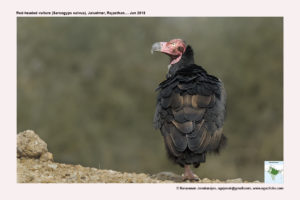Red-headed Vulture

Red-headed Vulture Sarcogyps calvus
Etymology:
- Sarcogyps : Greek word sarx – flesh; gups- vulture
- calvus : Latin word for “ bald”
Vernacular Names:
Hindi: Raajgidh, Mullagidh, Bhaonra, Pun: Raajgidh, Raajgirj/gidh, Bi: Kannaragidh, Ben: Raajshakun, Kaloshakun, Ass: Rojaxagun, Tamulixagun, Cachar: Lalgidh, Lepcha: Loongnongloong, Te: Nallaborawa, Mar: Rajgidhad
Distribution in India:Widespread resident in India.
Description: Size of 76–86 cm; wt. of 3600–5400 g; wingspan of 199–229 cm. It is a medium-sized, jet-black vulture with relatively small head and relatively slim, moderately fingered wings; pale grey band across base of flight-feathers from above and below. It has red sometimes more yellowish head and legs; orange lappets on sides of neck; in flight, white flank spots and chest, and tapered wing shape are distinctive. Iris is pale white to yellowish in adult male, dark red to red-brown in female . the female is marginally larger than male. The juvenile is dark brown with dark eye and flesh-coloured legs; in flight, shows distinctive white patches.
Habitat: It is found in open countryside, semi-desert, cultivated areas, savanna and deciduous woodland. It is found from foothills up to 2500m.
Food habits: It feeds on carrion, including small corpses; also pirates food from other vultures, especially Egyptian vulture, and from other raptors .It attends carcasses in company of other vultures, but usually less numerous. It is generally rather timid at carcasses, and is dominated by Griffons. It is opportunistic by taking scorched animals at burning grass fires.
Breeding habits: They breed in Nov–Sept in India. They build a large stick nest, lined with straw, animal remains and rubbish up in large tree, above ground on top of smaller bushes. The display flights are more acrobatic than those of other Asian vultures, with mutual soaring and cartwheeling. They lay a clutch of 1 egg. The incubation is done by both sexes. The incubation period is 45 days.